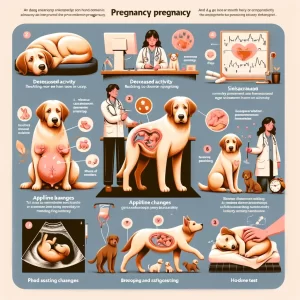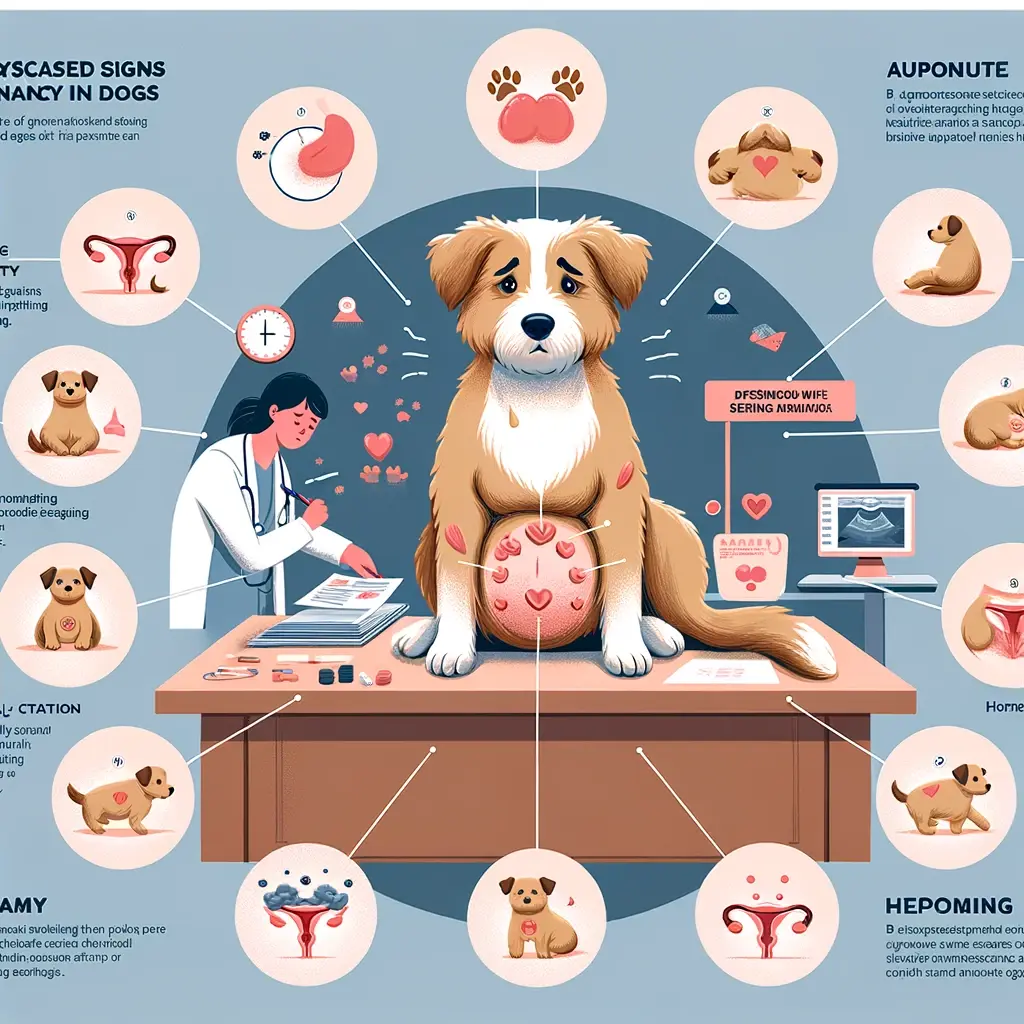A dog pregnancy is the most beautiful time for your doggo and its puppies. But the care can be time-consuming and costly.
In addition, there are changes in hormones, weight, appetite, and behavior in dogs similar to humans. However, pregnancies need not be stressful if you are better prepared to care for them.
Pregnancy in dogs lasts for 62-64 days or about 2 months. But how to tell if your dog is pregnant? Look for physical signs like laziness, appetite changes, mood swings, swollen nipples, and weight gain. If confused, consult a vet for an ultrasound and hormone checkup.
Every dog owner needs to be familiar with the breed’s standard and individual breed health tests to raise healthy well-socialized puppies.
Therefore, it is essential to give proper prenatal care and attention to your pregnant dogs. In addition, you need to consult a veterinarian about medications and food for pregnant dogs and not force them into exhausting activities.
So, keep reading this article to learn more information on caring for your pregnant canine.
Contents
How to Tell if Your Dog is Pregnant?
If your dog has been acting lazier than usual or eating less food, these could be the signs of pregnancy or illness.
The dogs may seem normal in the first few weeks, but there will be some indications as time passes. Your dogs may need to be tested for any infectious disease beforehand.
What are the Physical Signs of Pregnancy in Dogs?
Some symptoms like changes in appearance, appetite, or no exercise can be signs of other illnesses, so it is essential to get them checked. In addition, your dog should be at least 22 days pregnant for the pregnancy test to be accurate.
A few of the symptoms of a pregnant dog are bodily changes in them, as listed below.
1. Decreased Activity
When your dog is pregnant, the most common sign is a sudden decrease in energy levels. Your dog may quickly become exhausted and spend most of the time napping due to hormonal changes.
The pregnancy may make them feel tired and worn out. There are chances that our dogs may tire quickly during exercise.
Once they are pregnant, this change is seen in a few weeks. It is the first sign of fertilization. Some dogs may experience more fatigue than others. However, this fatigue passes away, and they have a normal energy level until the end of pregnancy.
2. Appetite Changes
Pregnant dogs can also experience morning sickness, resulting in decreased appetite. In addition, the vomiting sensation makes it difficult for your pregnant dogs to eat.
Nausea in dogs reduces as the pregnancy progresses. In some cases, she might eat more than usual. An increase in food is too good if avoided during the initial period, and extra weight gain may affect the pregnant dog.
You need to increase their food intake slowly by about 25% per week. Few dogs go through several appetite ups and downs. If your pet dog throws up during the initial period, do not try to force it to eat.
3. Unusual Behavior
A dog showcases behavioral changes often due to changes in hormones during pregnancy. For example, she might need the comfort of her owner and turn more affectionate and clingier.
During pregnancy, your pet wants to spend more time with you. But this is not always the case. In a few instances, your dogs may behave aggressively. Some would desire to be alone and isolated with no contact. She even might be depressed or behave unpredictably when given attention.
4. Weight Gain
It is common for dogs to put on weight during pregnancy. This is because your dog’s abdomen expands when the puppies grow. So, if your pets begin to gain extra weight, it can be a clear sign of pregnancy unless it has an underlying condition.
Most dogs do not start to gain weight until later. Weight increases up to 50% of its average weight once the seven-week mark is crossed. The amount of weight your pet dog gains depends on the breed.
Smaller dogs will gain less weight than larger ones. Many dogs gain fat weight to prepare for feeding the puppies, so weight is not the only representation of how many puppies it is carrying.
5. Swollen Nipples
Swollen nipples are one of the most noticeable changes in your dog if it is pregnant. Initially, the dog’s nipples are small, and pregnancy causes it to grow in size during the early stages of pregnancy.
The areolas become rounded compared to the usual flatness. You may also notice our dog’s nipples turning somewhat changing color. They turn slightly darker red as it indicates an increase in blood flow. The dog’s nipples may occasionally leak milk. The size may also increase significantly.
6. Brooding and Cuddling Behavior
Few dogs tend to tear their bedding and other materials to create a nest towards the end of their pregnancy. However, it may also appear irritable and withdrawn.
Before entering labor, dogs tend to show nesting behaviors, which include wanting a safe and quiet protected place to rest. You can also ensure that blankets are arranged to make it feel safe and protected. As an owner, you have to keep it warm and cozy so that the puppies do not feel cold.

Diagnostic Testing Methods to Check if Your Pet Dog is Pregnant
Apart from physical factors, few procedures indicate pregnancy in your dogs and require the vet’s services.
So, the following are some diagnostic testing methods to check your dog’s pregnancy.
1. Palpation
Palpation means feeling the uterus with bare hands. The vet can perform abdominal palpation between 3 to 4 weeks of gestation. During this time, the puppies feel like grapes or little golf balls.
These balls are fluid-filled sacs surrounding the fetus, and they lose their shape after one month. Therefore, it is advisable not to try at home and must be conducted by a vet.
2. Ultrasound
The vet can carry ultrasonography between 25 to 35 days of gestation. An ultrasound can detect the heartbeats of the puppies. It will also determine the number of puppies your pet is carrying.
3. X-Ray
It is done at 55 days of gestation as the puppies are well mineralized at this time. It allows estimation of the puppy’s size and position. The tiny ones are easily visible when an x-ray has been performed on an empty stomach.
4. Hormone Test
It is a simple blood test to confirm pregnancy and is carried out after 28 days. Relaxin produced during pregnancy confirms the report.
Healthy Dogs Guide: How to Care for a Pregnant Dog
Once your dog is pregnant, you need to attend to its special needs. There are several ways to prepare for its delivery.
Here are a few care tips to follow.
Give It Nutritious Food
Your dog needs wholesome nutrition-filled food during pregnancy. It requires more calories and nourishing food to meet its daily requirement. If the dog is already at a proper weight, you need to maintain the quality of dog food.
During pregnancy, dogs must be fed with puppy food. Therefore, her health will be in proper condition, and she will not need vitamins or supplements if she is on a good diet.
Make It Do Light Exercises
Dogs must be fit, as giving birth to many puppies requires energy and strength. As the dogs are likely to be tired, it is better to take short walks.
Vets feel that limiting strenuous exercise will enhance the implantation of the embryos. Therefore, walking is to be done keeping in mind the climate and the condition of the parks and roads.
Take It for Regular Vet Visits
Your dog needs to see the vet regularly at intervals during the pregnancy. An ultrasound or X-ray can be done between 21 days and 45 days of pregnancy to check the number and size of the puppies.
Besides, a professional vet says that vaccinations must be given before the pregnancy as mother dogs pass their immunity to their puppies. Dogs are not to be vaccinated during pregnancy. Any sign of vaginal bleeding or discharge requires immediate attention from the vet.
Prepare the Dog for the Birth
It is better to be equipped with the required supplies once the labor day nears. At the end of the pregnancy, your dog might have gained much weight, and you might have also seen puppies’ movement inside the mother.
By this time, you have to be ready with a whelping box. It is a nesting box designed to protect puppies during birth to protect them from external factors like the cold. First, however, you need to get the dog accustomed to the whelping box so that it delivers in that box.
What is Whelping?
Whelping refers to the process of a dog giving birth. Dog whelping occurs when the uterus begins to contract and causes the cervix to dilate.
Pregnant mothers may cease having food a few days before whelping and start to build a nest. When the puppies are born, they are enclosed in their placental membrane, and the mother licks the puppy to tear off the membrane.
If the mother does not do it, you need to remove it as puppies may not survive more than a few minutes. The umbilical cord needs to be cut if the dog cannot do it.
Prepare for whelping by having the below-listed items ready.
- Whelping Box – The whelping box can be store-bought or made at home.
- Whelping Mat – You can use blankets and towels for the dogs to feel comfortable.
- Digital Thermometer – To check the pregnant dog’s temperature, keep a digital thermometer ready. You need to get ready for labor when it falls to 98-99.
- Heat Lamp – It needs to be used to regulate the body temperature of newborn puppies.
- Puppy Scale – Keep a puppy scale near your hand to weigh the puppies when they’re born.
- Indoor/Outdoor Thermometer – Get hold of this thermometer to monitor the temperature of the whelping box.
- Hand Towels and Washcloths – Keep these items ready to clean the pregnant dog and puppies once delivered.
Potential Dog Labor Complications
Breeding a dog is not an easy process. It is time-consuming and a messy one. If our pet has not been delivered within 63 days, it is safer to check with the vet. Many problems may arise during labor, and dystocia is the main complication.
1. Dystocia
Dystocia is the term used when the mother is not progressing through labor. It can be due to the size or position of the fetus in the birth canal and maternal problems like poor contractions, an infection in the uterus, or the pelvis being narrow either to breed or a previously damaged pelvis.
2. Umbilical Cord and Amniotic Sac Problems
When the mother cannot sever the amniotic sac that the puppies come enclosed in or chew off the umbilical cord due to exhaustion or not knowing how to do it, the puppies cannot breathe. In such a case, the owner needs to clean the amniotic sac and cut the umbilical cord to ensure that the puppies breathe.
3. Birthing Difficulties in Brachycephalic Breeds
This problem is mainly seen in Brachycephalic breeds like pugs, bulldogs, and French Boxers due to the larger size of puppies being born than the mother’s pelvis.
It results in the malformation of a few body parts of the puppies, leading to further cardiac and respiratory issues. However, this is caused due to human interventions in natural dog breeding and is thus preventable.
Nevertheless, nutritious food with required supplements and fluid intake is essential for your pregnant dogs.
Although your dog might be able to deal with labor themselves, it helps if you are near them to offer support in case of an emergency.
If there are few complications like discolored discharge or your pet is straining too much, there is an immediate need for intervention and vet consultation.








